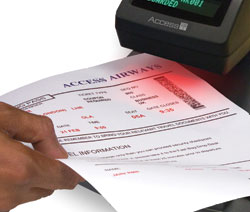 Whether your ticket is read face-up or face-down by the scanner can have a significant impact on how long passengers are kept waiting – as Access IS explains.
Whether your ticket is read face-up or face-down by the scanner can have a significant impact on how long passengers are kept waiting – as Access IS explains.
Bar codes printed on different sizes and shapes of paper or card are now presented at check-in desks, security points, and boarding gates. There have also been successful trials to present them on mobile phones and personal digital organisers (PDAs) – a trend that may grow.
This variety of media makes accurate, first-pass scanning harder and trials have shown that reading a document face-up achieves faster boarding than placing a document face-down.
When the trials compared the reading methodology, they found that a face-up reader made it easier for the agents to see the barcode location and confirm that it’s within the scanning target area. The face-down method required every document to be turned over, adding a small delay each time, and because agents are unable to see the location of the barcode on the document, it’s harder to get the barcode positioned correctly at the first attempt.
The imaging device of a face-down scanner can also be affected by glare from overhead lights or sunlight and the glass surface will accumulate scratches, finger prints, adhesive, ink and airborne debris – adding to scanning errors. With bar codes on phones and PDAs the problem gets worse.
In contrast, for face-up devices, the scanning surface is, by design, protected from overhead lights and glare from stray sunlight and the scanner optics are separated from the media or phone that it’s scanning ensuring that users cannot scratch the device or contaminate the reader.
By achieving faster passenger processing and boarding, face-up scanning is the logical choice.







